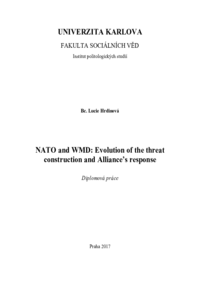NATO and WMD: Evolution of the threat construction and Alliance's response
NATO a zbraně hromadného ničení: vývoj konstrukce hrozby a následná reakce Aliance
diplomová práce (OBHÁJENO)

Zobrazit/
Trvalý odkaz
http://hdl.handle.net/20.500.11956/2244Identifikátory
SIS: 165807
Katalog UK: 990021268780106986
Kolekce
- Kvalifikační práce [19618]
Autor
Vedoucí práce
Oponent práce
Ludvík, Jan
Fakulta / součást
Fakulta sociálních věd
Obor
Bezpečnostní studia
Katedra / ústav / klinika
Katedra mezinárodních vztahů
Datum obhajoby
9. 2. 2017
Nakladatel
Univerzita Karlova, Fakulta sociálních vědJazyk
Angličtina
Známka
Výborně
Diplomová práce s názvem "NATO and WMD: Evolution of the threat construction and Alliance's response" se zabývá vývojem chápání zbraní hromadného ničení v Severoatlantické alianci. Zbraněmi hromadného ničení (ZHN) se NATO zabývá již od počátku své existence, nicméně důraz byl až do skončení studené války kladen převážně na jednu z kategorií, a to jaderné zbraně. Avšak od počátku 90. let je patrné, že se Aliance zaměřuje na ZHN jako zastřešující pojem pro biologické, chemické, jaderné a od teroristických útoků z 11. září 2001 i radiologické zbraně. Přestože se jedná o významný koncept, není vymezení zbraní hromadného ničení zcela jednoznačné. Avšak to, jak aktéři ZHN chápou, je velmi důležité. Z tohoto důvodu je zkoumán oficiální diskurz NATO jako indikátor chápání ZHN v Alianci, přičemž tento postup také umožní splnit dva cíle této práce. Prvním cílem je analýza vývoje konstrukce a interpretace hrozby ZHN v NATO od roku 1991 až po současnost. Zadruhé chce práce zjistit jakým způsobem NATO odpovědělo na hrozby plynoucí ze zbraní hromadného ničení (tj. proliferace a terorismu) a identifikovat konkrétní opatření, jež byla přijata v rámci boje s rozvíjející se hrozbou ZHN. Tato diplomová práce vychází z teorie sekuritizace, jež umožňuje nahlížet na bezpečnost a hrozby jako na sociálně konstruované....
This Diploma Thesis called "NATO and WMD: Evolution of the threat construction and Alliance's response" deals with the evolution of understanding of Weapons of Mass Destruction (WMD) within the North Atlantic Treaty Organization (NATO). WMD, especially the nuclear ones, have preoccupied NATO since its establishment. However, it was only after the end of the Cold War that NATO started to focus on WMD as a specific overarching category, consisting of chemical, biological and nuclear (since 9/11 also radiological) weapons. Despite the conspicuousness of the concept and increased use of the WMD term, the definition of weapons of mass destruction is not clear-cut. However, the way the actors understand WMD is very important. For this reason, NATO's official discourse is studied as an indicator of how is WMD understood in the Alliance, which will allow to fulfill objectives of this thesis. First, the work intends to analyze how has the WMD threat been constructed and interpreted within the Alliance since the year 1991 until this day. Secondly, this thesis aims to find out what is NATO's response to the dangers posed by the identified WMD threats (i.e. proliferation and terrorism) and identify the concrete measures the Allies undertook to tackle the evolving WMD threat. This thesis is based on...
